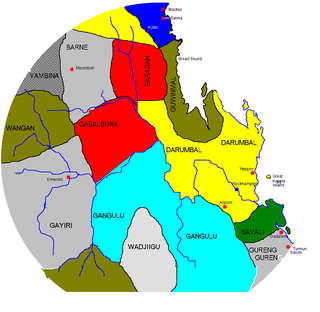Kaurna is a Pama-Nyungan language historically spoken by the Kaurna peoples of the Adelaide Plains of South Australia. The Kaurna peoples are made up of various tribal clan groups, each with their own parnkarra district of land and local dialect. These dialects were historically spoken in the area bounded by Crystal Brook and Clare in the north, Cape Jervis in the south, and just over the Mount Lofty Ranges. Kaurna ceased to be spoken on an everyday basis in the 19th century and the last known native speaker, Ivaritji, died in 1929. Language revival efforts began in the 1980s, with the language now frequently used for ceremonial purposes, such as dual naming and welcome to country ceremonies.

The Gamilaraay or Kamilaroi language is a Pama–Nyungan language of the Wiradhuric subgroup found mostly in south-eastern Australia. It is the traditional language of the Gamilaraay (Kamilaroi), an Aboriginal Australian people. It has been noted as endangered, but the number of speakers grew from 87 in the 2011 Australian Census to 105 in the 2016 Australian Census. Thousands of Australians identify as Gamilaraay, and the language is taught in some schools.
Ngardi, also spelt Ngarti or Ngardilj, is an Australian Aboriginal language that is considered moribund. It was previously thought to be an alternative name for the Bunara language, but these are now classified as separate languages. It was/is spoken by the Ngarti people of the Northern Territory and northern Western Australia.

Yarli (Yardli) was a dialect cluster of Australian Aboriginal languages spoken in northwestern New South Wales and into Northeastern South Australia individually Malyangapa (Maljangapa), Yardliyawara, and Wadikali. Bowern (2002) notes Karenggapa as part of the area, but there is little data.

Arabana or Arabuna is an Australian Aboriginal language of the Pama–Nyungan family, spoken by the Wongkanguru and Arabana people.

The Gangulu people, also written Kangulu, Kanolu, Kaangooloo, Ghungalu and other variations, are an Aboriginal Australian people from the Mount Morgan area in Queensland, Australia.
Dhauwurd Wurrung is a term used for a group of languages spoken by various groups of the Gunditjmara people of the Western District of Victoria, Australia. Keerray Woorroong is regarded by some as a separate language, by others as a dialect. The dialect continuum consisted of various lects such as Kuurn Kopan Noot, Big Wurrung, Gai Wurrung, and others. There was no traditional name for the entire dialect continuum and it has been classified and labelled differently by different linguists and researchers. The group of languages is also referred to as Gunditjmara language and the Warrnambool language.
The Pantyikali (Bandjigali) dialect, also called Baarundji or Weyneubulcoo , is a dialect of the Paakantyi language. Pantyikali is spoken in New South Wales, Australia, northwest, north, and west of White Cliffs. It is presumably extinct, with only one speaker remaining in 1981.
Kukatj, also rendered Gugadj, is an extinct Paman language of the Cape York Peninsula, Queensland, Australia. The name Kalibamu has also been assigned to it, although this may be a separate dialect. It is spoken by the Kukatj people. A single speaker was last recorded in 1975.

Barunggam (Murrumningama) is an extinct Aboriginal language spoken by the Barunggam people of Queensland in Australia. The Barunggam language shared many words with the neighboring languages, including Jarowair to the east, Wakka Wakka to the north and Mandandanji to the west. Kite and Wurm describe Barunggam as a dialect of Wakka Wakka.
Wanggamala, also spelt Wanggamanha, Wangkamahdla, Wangkamadla, Wangkamanha, Wangkamana, Wonkamala, Wongkamala, Wonkamudla, and other variants, is an extinct Australian Aboriginal language of the Pama–Nyungan family, previously spoken in the Northern Territory around Hay River and to the south of the Andegerebinha-speaking area.
The Wemba Wemba language is an extinct Aboriginal Australian language once spoken along the tributaries of the Murray River.
Madhi-Madhi, also known as Muthimuthi or Madi Madi, is an Indigenous Australian language spoken by the Muthi Muthi Aboriginal people of New South Wales.
Biri, also known as Biria, Birri Gubba, Birigaba, Wiri, Perembba and other variants, is an Australian Aboriginal language of the Mackay area of Queensland spoken by the Birri Gubba people. There are at least eight languages regarded as dialects of Biri, and two which are related but whose status is not yet fully determined. All are covered in this article.
The Paakantyi, or Barkindji or Barkandji, are an Australian Aboriginal tribal group of the Darling River basin in Far West New South Wales, Australia.
Luise Anna Hercus, née Schwarzschild, was a German-born linguist who lived in Australia from 1954. After significant early work on Middle Indo-Aryan dialects (Prakrits) she had specialised in Australian Aboriginal languages since 1963, when she took it up as a hobby. Works authored or co-authored by her are influential, and often among the primary resource materials on many languages of Australia.
The Maraura or Marrawarra people are an Aboriginal group whose traditional lands are located in Far West New South Wales and South Australia, Australia.
The Naualko (Nhaawuparlku) were an indigenous Australian people of New South Wales.

The Kokatha language, also written Kukatha, Kokata, Gugada, and other variants, and also referred to as Madutara, Maduwonga, Nganitjidi, Wanggamadu, and Yallingarra and variant spellings of these, is an Australian Aboriginal language of the Western Desert group traditionally spoken by the Kokatha people, whose traditional lands are in the western part of the state of South Australia, north of the Wirangu people.







